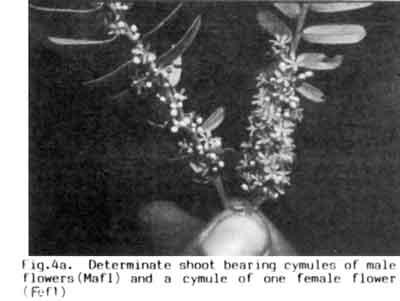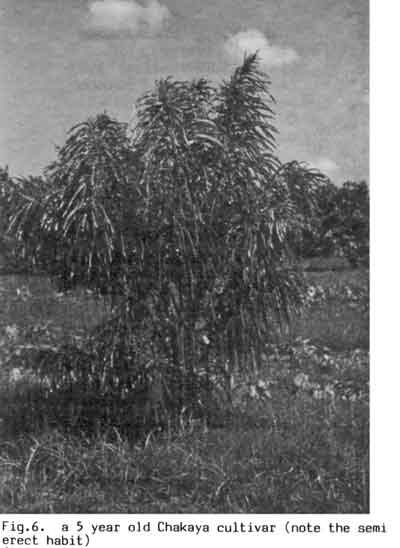
THE INDIAN GOOSEBERRY
SCIENTIFIC NAME: Emblica officinalis, Phyllanthus emblica
FAMILY: Euphorbiaceae
The Indian gooseberry plant is popularly known as the 'Wonder tree' in South East Asia. In India this tree is extensively exploited by the pharmaceutical industry for its many medicinal properties.
USES
In India the plant is used in the preparation of Ayurvedic Medicine - herbal medicine - used for the treatment of haemorrhoids, diarrhoea, dysentery, anaemia, jaundice, dyspepsia, cough, disease of eye and stomach ailments. Besides, it is used in the preparation of health tonics. Emblica's fruit, bark and leaves are rich in tannins.
Extracts from the fruit and other parts of plant are reported to have anti-microbial properties; inhibits the Potato Virus X growth and is known to induce juvenomimetic activity in insect nymphs. It has been reported that several types of alkaloids, flavonoids, quinones, steroids and terpenoids are extracted from the Emblica tree, and these plant by-products are believed to have medicinal values.
The leaves are used as leaf mulch and in flower bed preparation and in potting mix.
The nutritional properties of the Gooseberry fruit is tabulated in Table 1, and the vitamin content in the fruit is given in Table 2. As may be seen in Tables 1 and 2, the fruit is rich in vitamins, particularly vitamin C (range from 200 to 1814 milligrams per 100 grams of fruit).
Furthermore, extracts from the gooseberry fruits are used extensively as an ingredient in the preparation of inks, hair dyes, oils and shampoos.
Emblica is also known by other names like Myrobalan plum, Indian Gooseberry, Amla and Aonia.
BOTANY
The Emblica tree is widespread in subtropical and tropical regions of the world. It belongs to the Family Euphorbiaceae. This family comprises numerous important economical plants, to name a few: Tapioca, Rubber tree, Castor oil tree, and some ornamentals such as Poinsettia, Crotons, and Sapium (Chinese Tallow-wood).
The Emblica tree is of medium height which is evergreen in the tropics and deciduous in the subtropical climatic zones. The tree bears two types of shoots, the short shoots called 'determinate shoots' which resemble that of a compound leaf (pinnate leaf) but are actually a branch with nodes and inter nodes. The long shoots called 'indeterminate shoots' form the main frame-work of the tree which is like a branch and has a continuous growth year after year. The determinate shoots are the ones that get shed off from the tree during winter months in the subtropical climate. For this reason, the tropics have two harvests in a year as compared to one in the cooler subtropics.

FLORAL BIOLOGY
The first few proximal nodes of the determinate shoots are barren (without leaves) and the succeeding nodes are with green but reduced. In the tropics, a second flesh of flowering for the second crop while the fruits are maturing from the first flowering. A second crop in the sub tropics is possible through hand defoliation five months after first bloom.
Fig.4a. Determinate shoot bearing cymules of male flowers (Mafl) and a cymule of one female flower
(Fefl, Fig.4a).
Male flowers are light yellow in colour but female flowers are green. A typical flower consists of perianth and androecium or gynaecium. Androecium consists of three segments dehiscing vertically. Female flowers have tiny green perianths and the number of perianth segments varies from 5 to 7, but generally 6 are observed. Female flowers take about 72 hours to open fully. Pedicel is very short. Disc is a lanceolate cup with 3 carpels. Style is short, connate, twice bifid and distally dilated.
Fruit is capsular (Drupaceous) with a fleshy exocarp. The cocci (endocarp) is rather thick and massive, eventually separating from a well-developed columella. Columella is trigonous and slender below the dilated apex. Seeds are two in locule and seed coat is dark chestnut brown. The fruit skin is translucent and thin. The fruit is divided in six segments or lobes longitudinally extending from the base to the apex by six whitish green lines faintly evident as ridges.
Genetically: Emblica has both polyploids with chromosome numbers varying from 98 to 104 (2n) and the tetraploids (4n=28). The vitamin C content was found to be directly proportional to the size of the fruit and size of the fruit is directly related to chromosome number.
Fruit Dormancy: After successful pollination and fertilization, the set fruits do not show any external symptom of fruit growth for about four months because the zygote and the endosperm nucleus rest for this period of time.
The main edible part of the fruit is mesocarp and the endocarp forms the hard stone in which seeds are encased. Fibres in the fruit may become apparent in a fibrous cultivar at harvest maturity. The major commercial cultivars (Table 4) of Emblica are Banarasi, Francis and Chakaiya.

Propagation: Seeds are removed by cutting the fruit longitudinally along with the stone. Seeds that are embryoless can be separated by floating them on water just before sowing. Selected seeds give 100% germination. However, soaking dried seeds in 500 ppm GA3 solution for 24 hours improves germination. Seedlings are raised for root stock in 25 cm pots, which may take about 4 months to attain 8 mm stem diameter for either grafting or budding. Forkert, patch and T budding are the most commonly used methods with 80 to 100% survival.
For the purpose of commercial cultivation, Emblica is generally planted at 8 m apart, however, closer planting can also be followed. It grows from sandy, loamy to clayey soil types from pH 5.5 to 8.0. It is advisable to plant the grafts/seedlings in well prepared pits with adequate compost, manure and top/garden soil for good results. The newly planted plant at first sheds leaves, which is not a symptom of their mortality. New leaves arise after the plants are properly established.
Nutrition: Depending on the growth of the tree and the fertility status of the soil, a 7- to 8-year-old tree requires 180-360 g N, 540 - 1080 g P and 180-360 g K per tree per year. This fertilizer dosage can be divided accordingly from year one to year eight. NPK is generally applied with the onset of bud break. In order to improve the fruit quality, retention and yield, besides NPK, a 0.1% solution B, Cu, Mn and Zn sprayed before, during and after flowering is highly beneficial.
Intercropping with seasonal or perennial vegetables is possible for the first five years. Emblica trees once established are hardy and resist well against drought. Generally no irrigation is needed during rainy and winter months. However, irrigation at 15-30 days interval under flood irrigation or at weekly intervals under sprinkler irrigation during dry spring and summers corresponding with period of flowering and fruit set is necessary. Trees are susceptible to waterlogging and therefore the site should be well-drained.
Fruit Harvest and Yield: The change of seed colour from creamy white to brown black is indicative of fruit maturity and the harvesting stage of the fruit (fruits available in August/September in Rockhampton area). Maximum vitamin C content is present in mature fruits. Immature fruits are acrid and low in vitamin C content and minerals. The tree starts giving a few Kg fruits in the earlier years which increases up to 100 kg per tree annually at 12 - 15 years of age.
WHERE DOES THIS WONDER TREE LEADS US
In Australia, we could cultivate it in our back yard both in the tropical and subtropical climatic regions stretching from Northern Queensland to down south into New South Wales, Victoria and South Australia and also in North Western region, Northern Territory and the outback, as Emblica performs well in dry, arid and slightly saline soils.
I had the opportunity of presenting Emblica pickle on the 'tasting table' at the Capricornia Branch and had also placed some seedlings on auction. Its fruits offer the richest source of natural vitamin C, which in dry powder form is not lost. In Australia, with some media information and advertising, the Emblica fruit products would find a ready acceptance market, especially in the Health Food Industry and at certain Asian stores.
The Rockhampton Botanical Garden has had a place for this wonder tree in its Japanese Garden for the past 10 years. Probably the landscaper knew the ornamental and aesthetic value beforehand in order to place it in such a picturesque position. It is time we, the garden enthusiast and fruit lovers, make provision for this rare fruit in our gardens and enjoy its fruits.
Table 1. Nutrient content in Emblica fruit as given in wealth of India (Anon, 1952) and Finlay Institute, USA.
| Constituent | Per cent | Constituent | mg/100 g |
|---|---|---|---|
| Moisture | 77.1* - 82.20 | Iron | 1.20 |
| Protein | 0.50 | Nicotinic acid | 0.20 |
| Fat | 0.10 | Vitamin 'C' | 200 - 1814 |
| Minerals | 0.5* - 0.70 | Carotene* | 0.01 |
| Fiber | 1.9 - 3.40 | Thiamine* | 0.03 |
| Carbohydrate | 14.10 - 21.89* | Ribloflavin* | 0.05 |
| Calcium | 0.012 - 0.05 | Niacin* | 0.18 |
| Phosphorus | 0.026 - 0.02 | Tryptophan* | 3.00 |
| Methionine* | 2.00 | ||
| Lysine* | 17.0 | ||
| * Reported from Finlay Institute. | |||
Table 2. Vitamin 'C' content in emblica fruit
| Content of Vitamin C (mg/100g fruit) | Place of cultivar | Investigator |
|---|---|---|
| 625 | Cuba | Navia, 1955 |
| 1170 | Florida, USA | Navia, 1955 |
| 1561.1 and 1814.0 | Florida, USA | Mustard, 1752 |
| 467 | Aon Park Florida, USA | Milton Kaplow (Quoted by Morton, 1960) |
| 1130 and 1325 | Homestead, Florida, USA | Lynch and Fuchs, Sr., 1955 |
| 900 | Puerto Rico | Asenjo, 1953 |
| 200 | Malaysia | Phang 1976 |
Table 3 contains recipes which were placed in the Recipe Department.
Table 4. Distinguishing characters of emblica cultivars
| Character | Banarsi | Francis | Chakaiya | Bansi Red | Seedling |
|---|---|---|---|---|---|
| A. Tree | |||||
| Form and growth | Spreading, Medium-tall | Erect, tall | Semi-erect, Medium height | Erect, tall | Erect, tall |
| Bearing | Shy to alternate bearer | Regular, good bearer | Prolific, regular bearer | Moderately regular bearer | Prolific, regular bearer |
| B. Fruit (Mature)* | |||||
| Size | Medium-Large, 3.75x4.54 cm | Large, 4.4x4.94 cm | Medium, 3.2x3.8 cm | Medium, 3.5x4.6 cm | Small, 2.3x2.7 cm |
| Weight | 69 g | 63.3 g | 63 g | 28 g | 12.5 g |
| Shape | Roundish | Oval | Flattened at base and roundish apex | Oval to slightly triangular | Roundish |
| Stalk | Short | Short | Short | Short | Short |
| Cavity | Shallow | Shallow | Deep | Absent | Absent |
| Segment Number | 6 | 6 - 8 | 6 | 6 | 6 |
| Colour | Whitish green | Light green | Greenish | Reddish, with whitish dots on fruit surface | Green with small white dots |
| Fibre | Slight | Slight | Fibrous | Fibrous | Very fibrous |
| Juice | Scanty to medium | Moderate | Scanty | Moderate | Scanty |
| Taste (astringency) | Moderate | Moderate | Astringent | Astringent | Very astringent |
| Stone Size | Medium | Large | Small | Medium | Small |
| Seed/pulp ratio | 1.21 | 1.22 | 1.17 | 1.17 | 1.15 |
DATE: May 1995
* * * * * * * * * * * * *
